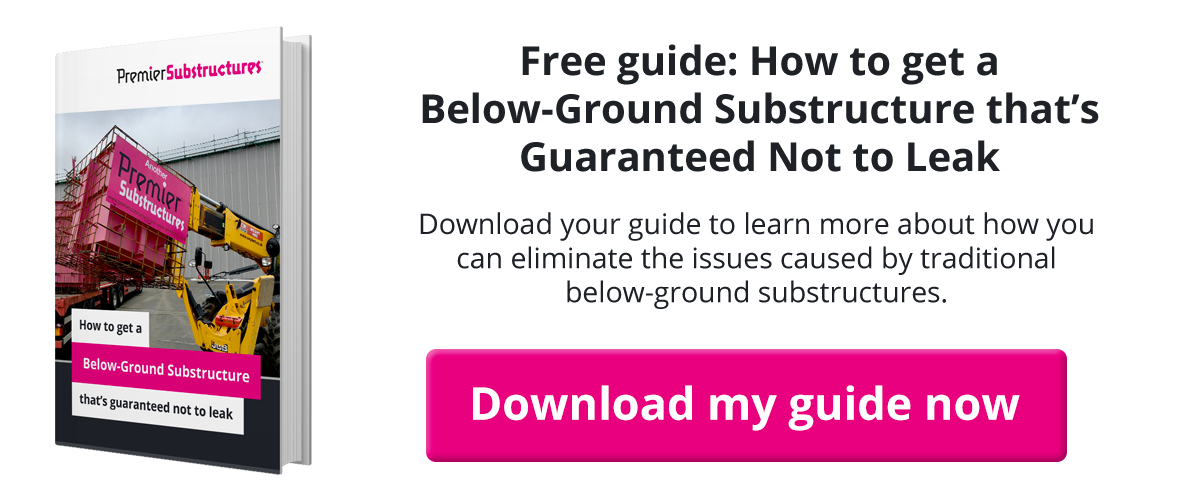Are you pondering the best way to construct a machine sump for your next project?
Regardless of the intended purpose of your machine sump, you’re going to need a reliable method of below-ground construction that’s completely watertight without too much risk for your project.
Unfortunately, traditional methods of below-ground construction – such as in situ concrete – are commonly known to leak over time. But what if I told you there was another way?
As a subcontractor who specialises exclusively in prefabricated steel, I’m going to tell you more about the differences between in situ and prefabricated steel machine sumps.
Constructing a machine sump using in situ concrete
Your project may already have been specified for in situ concrete – if it has, we wouldn’t be surprised, what with it being the most common below-ground construction method available. However, just because it’s long-established (and usually affordable) doesn’t mean it’s the best.
In situ is actually the most challenging method of below-ground construction, and involves a lot of risk. The machine sump you’re left with at the end of the day may be built to low tolerances, and may even be prone to leak over time (due to cracks when constructed).
Not to mention the risk of unskilled labour, as operatives must enter the excavation in order to complete the works. Add to that the good old British weather, plus the logistics of completing the job and transporting the materials, and you’re probably getting the idea it might not be all it’s cracked up to be (pardon the pun).
Despite this, in situ is usually the best solution if your substructure needs to cover a large area (like a very large sump, for example).
So, what’s the alternative? Well…
Constructing a machine sump using prefabricated steel
This is not something you’ve necessarily heard of before – and people don’t always immediately like what they don’t know – but hang on a minute.
Prefabricated steel is a newer, more innovative way of constructing below-ground. This type of substructure is manufactured entirely out of steel, off-site in a monitored factory environment under strict quality control.
So, what are the benefits?
Well, for starters, they won’t crack or leak. Imagine the hull of a ship – it’s constructed using steel plates which are welded together. No water gets in that way – so, for machine sumps which are constructed to hold water or oil, for example, you can be confident there’ll be no leaks.
A prefabricated steel machine sump can also last over 100 years in the ground – despite being exposed to the most acidic ground conditions. But another huge benefit is that it can be installed 70 – 80% faster than in situ!
So, if time is a significant factor for your project (and to be honest, this is usually the case), prefabricated steel can be your best option – as long as you’re able to order around six weeks in advance.
Last but certainly not least, prefabricated steel machine sumps are built to very, very high tolerances (+-3mm). This means lower maintenance costs over time.
TIP: Want to know more about steel prefabrication? Read my recent blog: ‘What is Steel Prefabrication Below-Ground and How Does it Work?’.
Advice from a specialist subcontractor
Most of the time, main contractors and construction companies are unaware of what we do with prefabricated steel, so using in situ (or alternatively, precast concrete) is pretty standard for constructing machine sumps.
However, you can’t argue with the benefits of prefabricated steel, so consider the speed and other advantages, compared to the risks of in situ concrete.
As for cost, as a rule of thumb; the longer and thinner your machine sump, the more economical off-site prefabricated steel can be. However, install time and water tightness could also lead to significant savings when considering the downtime of installing with in situ concrete.
Remember, water tightness is probably a big factor when constructing your machine sump, and using riskier methods such as in situ might not be the smartest choice, so why not get in touch with us today to find out how we might be able to help?
Conclusion
I hope you’ve found this blog helpful when comparing different construction methods for your machine sump. My best advice is to weigh up the risks and other significant factors that are driving your project, and see if there’s another way to do things.
If you think you might like to learn more about whether prefabricated steel might be a good option for your machine sump, I’d urge you to get in touch with us to discuss your options further – we’re happy to listen, and offer a completely bespoke service.
Alternatively, if you have any more general questions, just leave me a comment below – I’ll be happy to reply with something helpful!

